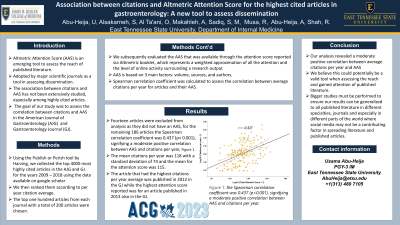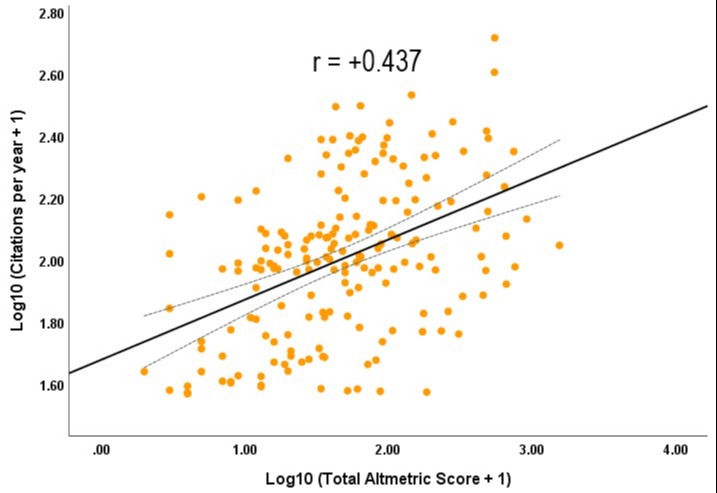Sunday Poster Session
Category: Practice Management
P1210 - Association Between Citations and Altmetric Attention Score for the Highest Cited Articles in Gastroenterology: A New Tool to Assess Dissemination
Sunday, October 22, 2023
3:30 PM - 7:00 PM PT
Location: Exhibit Hall

Has Audio

Usama Abu-Heija, MBBS
East Tennessee State University
Johnson City, TN
Presenting Author(s)
Usama Abu-Heija, MBBS1, Saqr Alsakarneh, MD2, Omar Al Ta'ani, MD3, Asaiel Makahleh, MD1, Syed Madeeha Sadiq, MD1, Musa Rasheed, MD1, Abu-Heija Ahmad, MD4
1East Tennessee State University, Johnson City, TN; 2University of Missouri-Kansas City, Kansas City, MO; 3Allegheny Health Network, Pittsburgh, PA; 4Wayne State University, Detroit, MI
Introduction: Altmetric Attention Score (AAS) is an emerging tool to assess the reach of published literature, with adoption by major scientific journals as a tool in assessing dissemination. The association between citations and AAS has not been extensively studied, especially among highly cited articles. The goal of our study was to assess the correlation between citations and AAS in the American Journal of Gastroenterology and Gastroenterology Journal.
Methods: Using the Publish or Perish tool by Harzing, we collected the top 4000 most highly cited articles in the Gastroenterology Journal and the American Journal of Gastroenterology for the years 2009 – 2018 using the data available on google scholar, we then ranked them according to per year citation average. The top one hundred articles from each journal with a total of 200 articles were chosen and we subsequently evaluated the AAS that was available through the attention score reported via Altimetric booklet, which represents a weighted approximation of all the attention and the level of online activity surrounding a research output and is based on 3 main factors: volume, sources, and authors. Spearman correlation coefficient was calculated to assess the correlation between average citations per year for articles and their AAS.
Results: Fourteen articles were excluded from analysis as they did not have an AAS, for the remaining 186 articles the Spearman correlation coefficient was 0.437 (p< 0.001), signifying a moderate positive correlation between AAS and citations per year, Figure 1. The mean citations per year was 118 with a standard deviation of 74 and the mean for the attention score was 115. The article that had the highest citations per year average was published in 2012 in the Gastroenterology Journal while the highest attention score reported was for an article published in 2013 also in the Gastroenterology journal.
Discussion: Our analysis revealed a moderate positive correlation between average citations per year and AAS, thus, we believe this could potentially be a valid tool when assessing the reach and gained attention of published literature. However, bigger studies must be performed to ensure our results can be generalized to all published literature in different specialties, journals and especially in different parts of the world where social media may not be a contributing factor in spreading literature and published articles.

Disclosures:
Usama Abu-Heija, MBBS1, Saqr Alsakarneh, MD2, Omar Al Ta'ani, MD3, Asaiel Makahleh, MD1, Syed Madeeha Sadiq, MD1, Musa Rasheed, MD1, Abu-Heija Ahmad, MD4. P1210 - Association Between Citations and Altmetric Attention Score for the Highest Cited Articles in Gastroenterology: A New Tool to Assess Dissemination, ACG 2023 Annual Scientific Meeting Abstracts. Vancouver, BC, Canada: American College of Gastroenterology.
1East Tennessee State University, Johnson City, TN; 2University of Missouri-Kansas City, Kansas City, MO; 3Allegheny Health Network, Pittsburgh, PA; 4Wayne State University, Detroit, MI
Introduction: Altmetric Attention Score (AAS) is an emerging tool to assess the reach of published literature, with adoption by major scientific journals as a tool in assessing dissemination. The association between citations and AAS has not been extensively studied, especially among highly cited articles. The goal of our study was to assess the correlation between citations and AAS in the American Journal of Gastroenterology and Gastroenterology Journal.
Methods: Using the Publish or Perish tool by Harzing, we collected the top 4000 most highly cited articles in the Gastroenterology Journal and the American Journal of Gastroenterology for the years 2009 – 2018 using the data available on google scholar, we then ranked them according to per year citation average. The top one hundred articles from each journal with a total of 200 articles were chosen and we subsequently evaluated the AAS that was available through the attention score reported via Altimetric booklet, which represents a weighted approximation of all the attention and the level of online activity surrounding a research output and is based on 3 main factors: volume, sources, and authors. Spearman correlation coefficient was calculated to assess the correlation between average citations per year for articles and their AAS.
Results: Fourteen articles were excluded from analysis as they did not have an AAS, for the remaining 186 articles the Spearman correlation coefficient was 0.437 (p< 0.001), signifying a moderate positive correlation between AAS and citations per year, Figure 1. The mean citations per year was 118 with a standard deviation of 74 and the mean for the attention score was 115. The article that had the highest citations per year average was published in 2012 in the Gastroenterology Journal while the highest attention score reported was for an article published in 2013 also in the Gastroenterology journal.
Discussion: Our analysis revealed a moderate positive correlation between average citations per year and AAS, thus, we believe this could potentially be a valid tool when assessing the reach and gained attention of published literature. However, bigger studies must be performed to ensure our results can be generalized to all published literature in different specialties, journals and especially in different parts of the world where social media may not be a contributing factor in spreading literature and published articles.

Figure: Figure 1, the Spearman correlation coefficient was 0.437 (p<0.001), signifying a moderate positive correlation between AAS and citations per year.
Disclosures:
Usama Abu-Heija indicated no relevant financial relationships.
Saqr Alsakarneh indicated no relevant financial relationships.
Omar Al Ta'ani indicated no relevant financial relationships.
Asaiel Makahleh indicated no relevant financial relationships.
Syed Madeeha Sadiq indicated no relevant financial relationships.
Musa Rasheed indicated no relevant financial relationships.
Abu-Heija Ahmad indicated no relevant financial relationships.
Usama Abu-Heija, MBBS1, Saqr Alsakarneh, MD2, Omar Al Ta'ani, MD3, Asaiel Makahleh, MD1, Syed Madeeha Sadiq, MD1, Musa Rasheed, MD1, Abu-Heija Ahmad, MD4. P1210 - Association Between Citations and Altmetric Attention Score for the Highest Cited Articles in Gastroenterology: A New Tool to Assess Dissemination, ACG 2023 Annual Scientific Meeting Abstracts. Vancouver, BC, Canada: American College of Gastroenterology.
